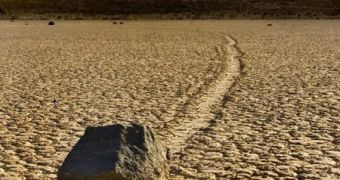California's Death Valley is a fairly harsh place when it comes to deserts, with temperatures regularly reaching 50 degrees Celsius (122 degrees Fahrenheit) during the day. At night, it gets so cold, that ice can form. In this rather inhospitable place, tourists and scientists have discovered one of the most unusual phenomenons they've ever seen, namely moving stones. Untouched by people's hands, the rocks appear to be actually gliding on the ultra-smooth surface of the desert, and experts have yet to fully explain this peculiar behavior.
The thing about these stones is that they appear to be traveling in eerie, straight patterns across the desert floor. According to geologists, they can cross distances of about 350 yards every single year. Exactly how they are able to do so remains a mystery. A possible explanation may be a union of various atmospheric conditions, including the formation of thin layers of clay at the surface of the desert, the appearance of ice at night, and 90-miles-per-hour winds. However, it's still unclear whether these are the only phenomena at work in this case, some experts say.
What's really peculiar is that not all stones move in the same direction, as one would expect if the wind played a major role in their motion. Rather, they cross paths, and some appear to be moving away from each other, as others are getting closer. They create criss-crosses on the desert's flat floor, which only serve to amplify their mystery. Forty-year-old photographer Mike Byrne has spent several years analyzing and documenting the motions. “Some of these rocks are as heavy as a person, it is really strange to imagine them gliding across the desert like this. They must be the original real-life rolling stones, they just keep moving through the sand and I don't believe anyone has really 100 per cent worked it out yet,” he tells the DailyMail.
“Most of the stones are found on an old lake bed, known as the Racetrack Playa, where the ground is particularly flat. It has been documented over the years and it is something very special to witness, although I know climatologists believe the phenomenon could disappear in a few years as the temps continue to rise. One of the strongest theories about what the rocks move is that water rising from beneath the surface of the sand is pushed by the wind creating a surface the rocks can move along,” he adds for the same publication.

 14 DAY TRIAL //
14 DAY TRIAL //